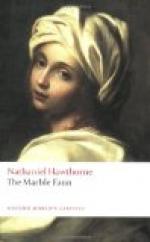Beneath the crucifix, on a table, lay a human skull, which looked as if it might have been dug up out of some old grave. But, examining it more closely, Kenyon saw that it was carved in gray alabaster; most skillfully done to the death, with accurate imitation of the teeth, the sutures, the empty eye-caverns, and the fragile little bones of the nose. This hideous emblem rested on a cushion of white marble, so nicely wrought that you seemed to see the impression of the heavy skull in a silken and downy substance.
Donatello dipped his fingers into the holy-water vase, and crossed himself. After doing so he trembled.
“I have no right to make the sacred symbol on a sinful breast!” he said.
“On what mortal breast can it be made, then?” asked the sculptor. “Is there one that hides no sin?”
“But these blessed emblems make you smile, I fear,” resumed the Count, looking askance at his friend. “You heretics, I know, attempt to pray without even a crucifix to kneel at.”
“I, at least, whom you call a heretic, reverence that holy symbol,” answered Kenyon. “What I am most inclined to murmur at is this death’s head. I could laugh, moreover, in its ugly face! It is absurdly monstrous, my dear friend, thus to fling the dead weight of our mortality upon our immortal hopes. While we live on earth, ’t is true, we must needs carry our skeletons about with us; but, for Heaven’s sake, do not let us burden our spirits with them, in our feeble efforts to soar upward! Believe me, it will change the whole aspect of death, if you can once disconnect it, in your idea, with that corruption from which it disengages our higher part.”
“I do not well understand you,” said Donatello; and he took up the alabaster skull, shuddering, and evidently feeling it a kind of penance to touch it. “I only know that this skull has been in my family for centuries. Old Tomaso has a story that it was copied by a famous sculptor from the skull of that same unhappy knight who loved the fountain lady, and lost her by a blood-stain. He lived and died with a deep sense of sin upon him, and on his death-bed he ordained that this token of him should go down to his posterity. And my forefathers, being a cheerful race of men in their natural disposition, found it needful to have the skull often before their eyes, because they dearly loved life and its enjoyments, and hated the very thought of death.”
“I am afraid,” said Kenyon, “they liked it none the better, for seeing its face under this abominable mask.”
Without further discussion, the Count led the way up one more flight of stairs, at the end of which they emerged upon the summit of the tower. The sculptor felt as if his being were suddenly magnified a hundredfold; so wide was the Umbrian valley that suddenly opened before him, set in its grand framework of nearer and more distant hills. It seemed as if all Italy lay under his eyes in that one picture.




